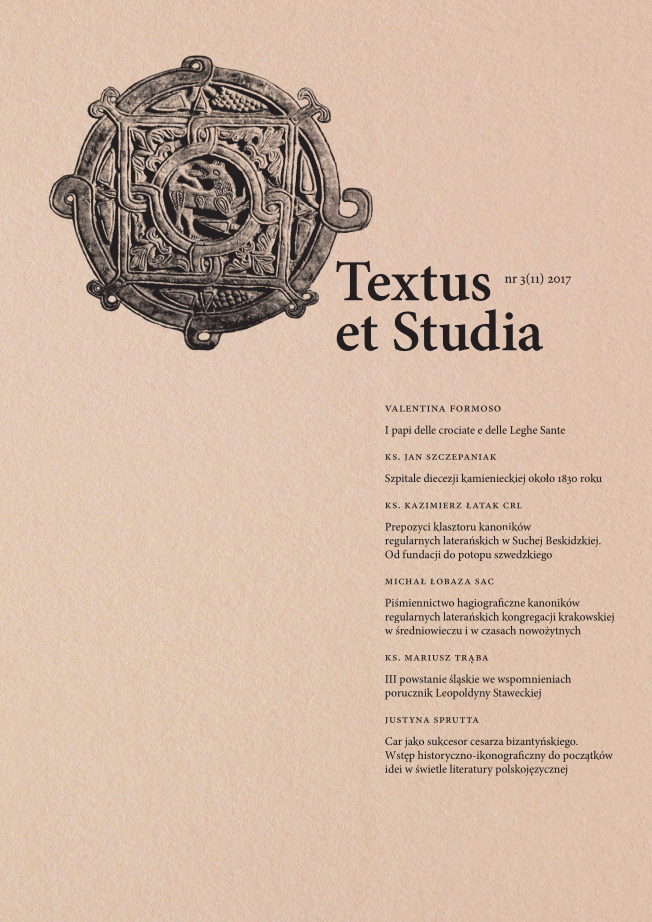Car jako sukcesor cesarza bizantyńskiego. Wstęp historyczno-‑ikonograficzny do początków idei w świetle literatury polskojęzycznej
DOI:
https://doi.org/10.15633/tes.03306Słowa kluczowe:
car, cesarz, Bizancjum, idea, sukcesja, ikonaAbstrakt
The article is based on native and foreign literature (Polish translations) and it presents the definition, meaning and reception of the idea of the czar as the successor of the Byzantine emperor on Russia as well as rituals connected with this succession. The article is only an introduction to the theme, which requires deepened reflection over the defined matter. In the second part of the article the icon of Militant Orthodox church in discussed. In one of its interpretation, the mentioned idea seems to be carnalized, though it seems not to be certain utterly.Bibliografia
Boroń P., Kniaziowie, królowie, carowie… Tytuły i nazwy władców słowiańskich we wczesnym średniowieczu, Katowice 2010.
Broda M., „Zrozumieć Rosję?” O rosyjskiej zagadce-tajemnicy, Łódź 2011.
Dąb-Kalinowska B., Ikony i obrazy, Warszawa 2000.
Encyklopedia kultury bizantyńskiej, O. Jurewicz (red.), Warszawa 2002.
Euzebiusz z Cezarei, Życie Konstantyna, tłum. T. Wnętrzak, Kraków 2007.
Fiedotow G., Święci Rusi (X–XVII w.), tłum. H. Paprocki, Bydgoszcz 2002.
Grotowski P.Ł., Święci wojownicy w sztuce bizantyńskiej (843–1261). Studia nad ikonografią uzbrojenia i ubioru, Kraków 2011.
Kepetzi V., Images de piété de l’empereur dans la peinture byzantine (X/XIII siècles) – Reflexions sur quelques exemples choisis [w:] Byzantinische Malerei. Bildprogramme. Ikonographie. Stil, G. Bühl (Hrsg.), Wiesbaden 2000.
Kobrzeniecka-Sikorska G., Wizerunki carów rosyjskich. Między ikoną a portretem, Olsztyn 2007.
Leksykon. Historia świata, W. Sienkiewicz (red.), Warszawa 2001.
Pawłow A., Perrie M., Iwan Groźny. Car i tyran, tłum. S. Kędzierski, Warszawa 2008.
Popova O., Smirnova E., Cortesi P., Ikony, tłum. T. Łozińska, Warszawa 2000.
Powieść minionych lat, tłum. i oprac. F. Sielicki, Wrocław–Warszawa–Kraków 1968.
Romanowski D., Trzeci Rzym. Rozwój rosyjskiej idei imperialnej, Kraków 2013.
Runciman S., Teokracja bizantyjska, tłum. M. Radożycka-Paoletti, Katowice 2008.
Sawicki D., Idee „Świętej Rusi” i „Trzeciego Rzymu” oraz ich miejsce w nauczaniu staroobrzędowców pomorskich, „Wschodni Rocznik Humanistyczny” 2013, t. 9.
Uspienski B., Car i imperator. Namaszczenie władcy i semantyka tytułów monarchy, tłum. H. Paprocki, Katowice 2002.
Uspienski B., Car i patriarcha. Charyzmat władzy w Rosji. Bizantyjski model i jego nowe rosyjskie ujęcie, tłum. i oprac. H. Paprocki, Katowice 1999.
Vodoff V., Remarques sur la valeur du term ‘tsar’ appliqué aux princes Russes avant le milieu du XVe siècle, „Oxford Slavonic Papers” 1978, No. 11, s. 1–41.
Zuber M., Opowiedzieć Rosję. Trzy pokusy, „Przegląd Filozoficzny – Nowa Seria” 2011, nr 1(77), s. 137–149.
Повесть временных лет, В.П. Адриановa-Перетц (ред.), Санкт-Петербург 2007.
Степовик Д., Українська икона. Iконотворчий досвiд дiаспори, Київ 2003.
Pobrania
Opublikowane
Numer
Dział
Licencja
Prawa autorskie (c) 2019 Justyna Sprutta

Praca jest udostępniana na licencji Creative Commons Attribution-NonCommercial-NoDerivatives 3.0 Unported License.
Autorzy publikujący w czasopiśmie udzielają jego wydawcy zgody o następującej treści:
- Autor zachowuje autorskie prawa majątkowe do utworu, a jednocześnie udziela wydawcy czasopisma zgody na jego pierwszą publikację w wersji drukowanej i wersji online na licencji Creative Commons Uznanie autorstwa 4.0 Międzynarodowe oraz zgody na wykonywanie opracowań, w tym przekładów.
- Autor ma możliwość udzielania zgody niewyłącznej na opublikowanie utworu w wersji, która ukazała się w czasopiśmie (np. zamieszczenia go w repozytorium instytucjonalnym lub opublikowania w książce), wraz z informacją o jego pierwszej publikacji w czasopiśmie.
- Autor może umieścić swój utwór online (np. w repozytorium instytucjonalnym lub na swojej stronie internetowej) jeszcze przed zgłoszeniem utworu do czasopisma.

